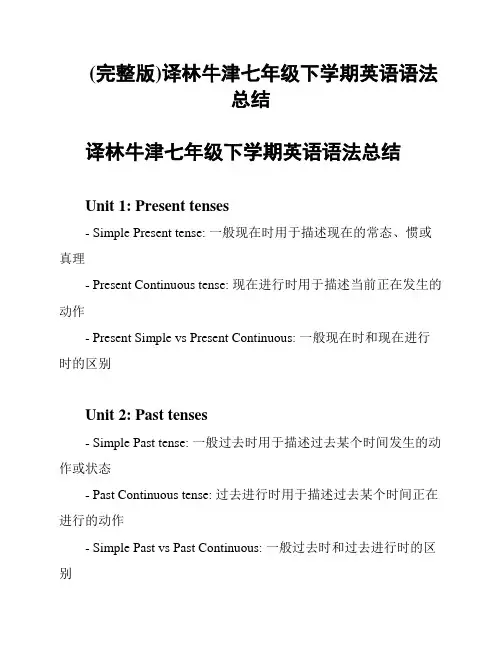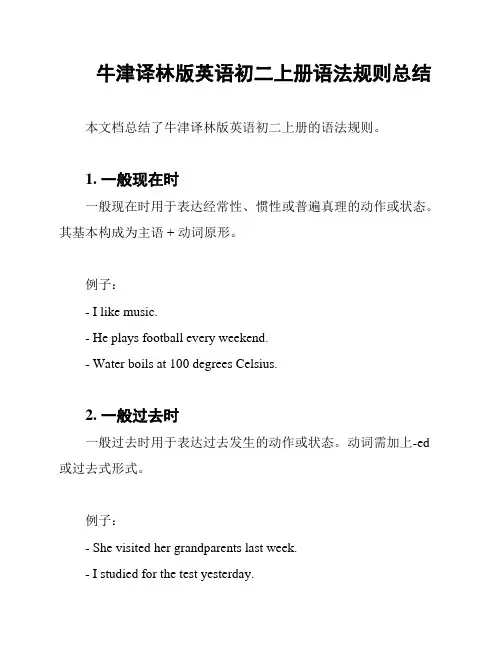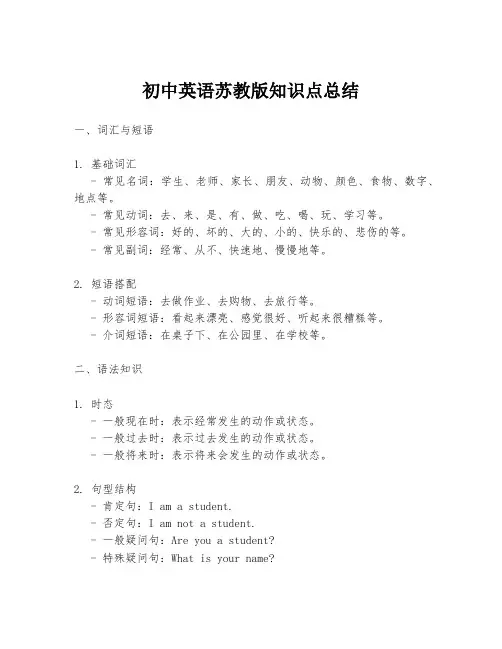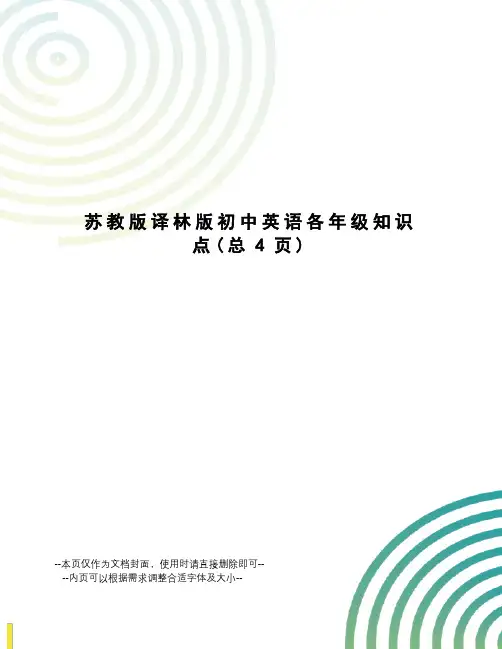苏教版译林牛津初中英语语法总结(初一初二)
(完整版)译林牛津七年级下学期英语语法总结

(完整版)译林牛津七年级下学期英语语法总结译林牛津七年级下学期英语语法总结Unit 1: Present tenses- Simple Present tense: 一般现在时用于描述现在的常态、惯或真理- Present Continuous tense: 现在进行时用于描述当前正在发生的动作- Present Simple vs Present Continuous: 一般现在时和现在进行时的区别Unit 2: Past tenses- Simple Past tense: 一般过去时用于描述过去某个时间发生的动作或状态- Past Continuous tense: 过去进行时用于描述过去某个时间正在进行的动作- Simple Past vs Past Continuous: 一般过去时和过去进行时的区别Unit 3: Future tenses- Will + verb: 表示将来的决定、打算或预测- Be going to + verb: 表示计划、意图或预测- Future Continuous tense: 将来进行时用于描述将来某个时间正在进行的动作- Future Simple vs Be going to: 将来时的两种表达方式的区别Unit 4: Passive voice- Active voice vs Passive voice: 主动语态和被动语态的区别- How to form the passive voice: 构成被动语态的方法- Passive voice with different tenses: 不同时态的被动语态形式Unit 5: Modal verbs- Can, could, may, might: 表示能力、允许或可能性- Must, have to: 表示必须、责任或推测- Should, ought to: 表示应该、建议或期望Unit 6: Conditionals- Zero conditional: 表示真理、自然法则或普遍情况- First conditional: 表示可能性、条件或可能的反应- Second conditional: 表示假设、不太可能的情况或对应的行动- Third conditional: 表示虚构、过去的假设或悔恨Unit 7: Reported speech- Reporting verbs: 常用的引述动词- Reporting statements: 直接引述陈述句的变化- Reporting questions: 直接引述疑问句的变化以上是译林牛津七年级下学期英语语法总结的内容。
牛津译林版英语初二上册语法规则总结

牛津译林版英语初二上册语法规则总结本文档总结了牛津译林版英语初二上册的语法规则。
1. 一般现在时一般现在时用于表达经常性、惯性或普遍真理的动作或状态。
其基本构成为主语 + 动词原形。
例子:- I like music.- He plays football every weekend.- Water boils at 100 degrees Celsius.2. 一般过去时一般过去时用于表达过去发生的动作或状态。
动词需加上-ed 或过去式形式。
例子:- She visited her grandparents last week.- I studied for the test yesterday.- They played basketball for two hours.3. 现在进行时现在进行时用于表达目前正在进行的动作。
其构成为主语 + am/is/are + 动词-ing形式。
例子:- We are watching a movie right now.- The baby is sleeping.4. 一般将来时一般将来时用于表达将来某个时间会发生的动作。
其构成为主语 + will + 动词原形。
例子:- We will go shopping tomorrow.- She will call you later.- They will visit their relatives next month.5. 一般过去将来时一般过去将来时用于过去将来某个时间会发生的动作。
其构成为主语 + was/were going to + 动词原形。
例子:- He said he was going to visit his parents yesterday.- I thought we were going to have a meeting last night.6. 祈使句祈使句用于表示命令、请求或建议。
初中英语苏教版知识点总结

初中英语苏教版知识点总结一、词汇与短语1. 基础词汇- 常见名词:学生、老师、家长、朋友、动物、颜色、食物、数字、地点等。
- 常见动词:去、来、是、有、做、吃、喝、玩、学习等。
- 常见形容词:好的、坏的、大的、小的、快乐的、悲伤的等。
- 常见副词:经常、从不、快速地、慢慢地等。
2. 短语搭配- 动词短语:去做作业、去购物、去旅行等。
- 形容词短语:看起来漂亮、感觉很好、听起来很糟糕等。
- 介词短语:在桌子下、在公园里、在学校等。
二、语法知识1. 时态- 一般现在时:表示经常发生的动作或状态。
- 一般过去时:表示过去发生的动作或状态。
- 一般将来时:表示将来会发生的动作或状态。
2. 句型结构- 肯定句:I am a student.- 否定句:I am not a student.- 一般疑问句:Are you a student?- 特殊疑问句:What is your name?3. 代词- 人称代词:I, you, he, she, it, we, they.- 物主代词:my, your, his, her, its, our, their.- 反身代词:myself, yourself, himself, herself, itself, ourselves, yourselves, themselves.4. 冠词- 不定冠词:a, an.- 定冠词:the.5. 介词- 表示时间:at, on, in.- 表示地点:at, on, in, under, above, behind.- 表示方向:to, towards, through.6. 连词- 并列连词:and, but, or, so.- 从属连词:because, since, although, if, when, while.三、阅读理解1. 文章类型- 记叙文:讲述人物、事件的故事。
- 说明文:解释事物的特性、原因、过程等。
苏教版译林牛津重点初中英语语法总结归纳(初一初二

补充:1.句子的构成初中一年级上语法1.in,on,at表示时间的应用in +parts of day(evening,morning,etc) /month/season/yearon + day (Sunday, etc)/date(1 July,etc)/parts of a special day( Sunday morning)/special holidays(Children’sDay)at + time of day (seven o’clock)/ age(6 years old)2.频率副词1.比较级、最高级的用法than作为比较级、the+最高级的用法+er 及+est 的用法,most+形容词表示最高级2. more…than, fewer….than,less..than, the most, the fewest, the least的用法3. as…as的用法4.反身代词的用法Myself, yourself, himself, herself, itself, ourselves, yourselves, themselves5.祈使句的用法肯定:Open the door.否定:Don’t close the window.礼貌些:Please….6.表示建议should和had better的用法7.may来表示可能性的用法(区别初一下7,may作为询问语气的用法)8.不定式用法9.用不定式表示目的,用in order to表示目的10. A.“动词+宾语+不定式”结构,即,动词+宾语+to do(不定式)可用这类结构的常用动词有?advise, allow, ask, bear, beg, bother, cause, command, determine, encourage, expect, forbid, force, get, hate, help, intend, invite, leave, like, mean, need, order, permit, persuade, prefer, request, remind, request, teach, tell, trouble, want, warn, wish等。
苏教版译林版初中英语各年级知识点

Unit3Teenage problems
Unit4Growing up
Unit5Art world
Unit6TV programmes
Unit7Films
Unit8Detective stories[侦探小说]
9B
Unit1Asia
Unit2Great people
Unit3Robots
Unit4Life on Mars
7A
1动词be的一般现在时
2行为动词的一般现在时
3人称代词
4表示时间的介词
5频度副词
6特殊疑问句
7可数名词和不可数名词
8用some和any表示数量
9 there beபைடு நூலகம்构
10 现在进行时
7B
1 基数词
2 序数词
3 一般将来时(will shall)
4 一般将来时(be going to)
4 一般过去时和过去进行时
5 一般过去时和现在完成时
6 简单句和复合句之间的转换(一)
7 简单句和复合句之间的转换(二)
苏教版译林版初中英语各年级知识点(总4页)
7A
Unit1This is me!
Unit2Let’s play sports!
Unit3Welcome to our school!
Unit4My day
Unit5Let’s celebrate!
Unit6Food and lifestyles
Unit7Shopping
Unit2Travelling
Unit3Online tours
Unit4A good read
Unit5Good manners[彬彬有礼]
苏教版(译林版)初中英语各册单元语法点复习梳理

Unit 2 Famous people
Tenses
A: Simple prese nt and prese nt con ti nu ous B: Simple past and past con ti nu ous
Unit 2 Colours
A: Object clauses in troduced by that
B: Object clauses in troduced by if or whether
Unit3Tee nage
problems
A: Object clauses in troduced by questi on words
A: Givi ng reas ons with because
B: Givi ng reas ons with sin cea nd as
Unit 6 TV programmes
A: Using if B: Using uni ess
Unit 7 Films
A: Using although/though B: Using so ... that and such ... that
Unit 8 Pets
A: Using adjectives B: Indefinite pronouns
8A
Unit1Frie nds
Comparative and superlative adjectives
Unit 2 School life
A: Compari ng the amount of things
Unit 3 Welcome to our school
译林版牛津英语七年级下册全册Unites1-8单元知识点及语法归纳
—-可编辑修改,可打印——别找了你想要的都有!精品教育资料——全册教案,,试卷,教学课件,教学设计等一站式服务——全力满足教学需求,真实规划教学环节最新全面教学资源,打造完美教学模式七年级英语下册知识点总结Unit 1 Dream homes一、重点词组、句型1、Would you like to live in the palace, Eddie? 埃迪,你想住宫殿里吗?①Would you like sth? 肯定回答:Yes, please. 否定回答:No, thanks.②Would you like to do sth? 肯定回答:Yes, I’d like/love to. 否定回答:I’d like/love to, but…2、There are twenty restaurants in town. 镇上有二十家餐馆。
There are about 8,000,000 people living in London. 大约有八百万人住在伦敦。
①表示某地有……,用there be 句型,谓语动词就近原则。
There __________(be) an art room, a music room and two computer rooms in our school.②表示有事情要做,用there be sth to do。
There are lots of things ___________(see) in Beijing..③表示有某人正在做某事,用there be sb doing sth.。
On game shows, there are always famous people___________(talk) about their lives.3、I live in a town 15 miles from London. 我住在离伦敦15英里的一个镇上。
be far (away) from 离……远,但出现具体距离时,不用farMy home is __________________from the school.My home is 5 kilometres ___________from the school. A. away B. far C. close D. next to 4. have fun with sb./sth. 和某人/某物玩得开心have fun doing sth. 做某事很开心have(has/had) fun= have(has/had) a good time= enjoy(enjoyed) onself(myself/yourself/youselves……)5、I also have a bedroom of my own. =I also have my own bedroom. 我也有自己的房间。
译林初中英语知识点总结
译林初中英语知识点总结一、词汇与短语1. 基础词汇- 常见名词:学生、老师、家庭、动物、食物、颜色、数字、职业等。
- 常见动词:吃、喝、玩、学习、工作、旅行等。
- 常见形容词:高兴的、悲伤的、美丽的、丑陋的、大的、小的等。
- 常见副词:快速地、慢慢地、经常、从不等。
2. 短语搭配- 动词短语:看起来(look like)、听起来(sound like)、玩得开心(have fun)、学习英语(learn English)等。
- 介词短语:在桌子下(under the table)、在公园里(in the park)、对…感兴趣(be interested in)等。
- 常用表达:问候(Hello/Hi)、道别(Goodbye/See you)、感谢(Thank you)、道歉(Sorry)等。
二、语法结构1. 时态- 一般现在时:表示经常发生的动作或状态,如:I go to school every day.- 一般过去时:表示过去某一确定时间发生的动作或状态,如:He visited the museum last week.- 一般将来时:表示将来某一时间会发生的动作或状态,如:They will travel to Japan next year.2. 句型- 肯定句:I am a student.- 否定句:I am not a student.- 疑问句:Are you a student?- 特殊疑问句:What is your name? / Where are you from?3. 语态- 被动语态:表示动作的承受者,如:The book was written by the author.4. 非谓语动词- 动名词:作为名词使用,如:Swimming is my hobby.- 分词:作为形容词或副词使用,如:The running boy is my friend.- 不定式:作为名词、形容词、副词等,如:To err is human.三、阅读理解1. 技巧- 快速阅读:通过扫读(skimming)和略读(scanning)快速获取文章大意。
译林牛津七年级上学期英文语法总结
译林牛津七年级上学期英文语法总结一、Present Simple TensePresent Simple Tense(一般现在时)用于表示经常性的动作、惯、真理或常识。
句子结构为主语 + 动词原形(第三人称单数加-s)。
例如:- I often play basketball after school.- He goes to the gym three times a week.- Water boils at 100 degrees Celsius.二、Past Simple TensePast Simple Tense(一般过去时)用于表示过去发生的动作或存在的状态。
句子结构为主语 + 动词过去式。
例如:- She watched a movie last night.- They visited their grandparents during the summer vacation.- Peter knew the answer to the question.三、Present Continuous TensePresent Continuous Tense(现在进行时)用于表示现在正在进行的动作。
句子结构为主语 + am/is/are + 动词-ing。
例如:- I am studying for the English exam right now.- They are playing soccer in the park.- She is reading a book at the moment.例如:- This book is more interesting than that one.- Tom is taller than his brother.- The red car is faster than the blue one.五、SuperlativesSuperlatives(最高级)用于表示多个事物中最高程度的特征。
最新苏教译林版初中英语语法概要大全精心整理
最新译林版初中英语语法概要【初一七年级上册】Unit1动词be的一般现在时Unit2行为动词的一般现在时Unit3人称代词Unit4表示时间的介词(in/on/at)频度副词Unit5特殊疑问词Unit6可数名词与不可数名词Unit7用some和any表示数量there be 结构Unit8现在进行时【初一七年级下册】Unit1基数词序数词Unit2一般将来时(will/shall)一般将来时(be going to)Unit3名词所有格形容词性物主代词和名词性物主代词Unit4冠词a/an/the方位介词Unit5一般过去时(1)Unit6一般过去时(2)Unit7情态动词can/could/mayWhat/How感叹句Unit8形容词不定代词【初二八年级上册】Unit1形容词比较级和最高级Unit2数量的比较副词比较级和最高级Unit3as...as的用法反身代词Unit4祈使句用should和had better提建议Unit5情态动词may的用法动词不定时作宾语Unit6动词不定时作目的状语动词不定时作宾语补足语Unit7动词及五种基本句型Unit8过去进行时when,while和as的用法【初二八年级下册】Unit1现在完成时(1)Unit2现在完成时(2)Unit3现在完成时(3)Unit4疑问词+动词不定式must和have to的用法Unit5enough to的用法too...to的用法Unit6It is +adj(for.../of)+to infinitive句型Unit7被动语态(1)被动语态的一般现在时和一般过去时Unit8被动语态(2)被动语态的一般将来时被动语态(2)。
- 1、下载文档前请自行甄别文档内容的完整性,平台不提供额外的编辑、内容补充、找答案等附加服务。
- 2、"仅部分预览"的文档,不可在线预览部分如存在完整性等问题,可反馈申请退款(可完整预览的文档不适用该条件!)。
- 3、如文档侵犯您的权益,请联系客服反馈,我们会尽快为您处理(人工客服工作时间:9:00-18:30)。
苏教版译林牛津初中英语语法总结(初一初二)
1、句子的构成初中一年级上语法
1、in,on,at表示时间的应用in +parts of
day(evening,morning,etc)
/month/season/yearon + day (Sunday, etc)/date(1 July,etc)/parts of a special day( Sunday morning)/special holidays(Children’s Day)at + time of day (seven
o’clock)/ age(6 years old)
2、频率副词never,
seldom,sometimes,often,usually,always
3、疑问副词的用法what,which,who,whose,when,why,how
4、可数名词与不可数名词
5、some和any的用法
6、There be句型
7、现在进行时及动词+ing的用法初中一年级下语法
1、序数词与基数词
2、一般将来时:will与shall、be going to
3、名词所有格名字+’s,
mine,yours,ours,theirs,his,hers,its
4、冠词 a,an, the的用法
5、表示方位的介词In front of,
behind,inside,outside,above,below,over,under
6、一般过去式及过去分词+ed的用法
7、can,could,may的用法
8、What 和 How开头的感叹句9形容词的用法,在句子中的
位置
10、不定代词的用法Somebody, someone, somethingAnybody, anyone, anythingNobody, no one, nothingEverybody, everyone, everthing初中二年级上语法
1、比较级、最高级的用法than作为比较级、the+最高级的
用法+er 及+est 的用法,most+形容词表示最高级
2、more…than, fewer…、than,less、、than, the most, the fewest, the least的用法
3、as…as的用法
4、反身代词的用法Myself, yourself, himself, herself, itself, ourselves, yourselves, themselves
5、祈使句的用法肯定:Open the door、否定:Don’t
close the window、礼貌些:Please…、6、表示建议 should和had better的用法
7、may来表示可能性的用法(区别初一下7,may作为询问语气的用法)
8、不定式用法
9、用不定式表示目的,用 in order to表示目的
10、
A、“动词+宾语+不定式”结构,即,动词+宾语+to do(不
定式)可用这类结构的常用动词有advise, allow, ask, bear, beg, bother, cause, command, determine, encourage, expect, forbid, force, get, hate, help, intend, invite, leave, like, mean, need, order, permit, persuade, prefer, request, remind, request, teach, tell, trouble, want, warn, wish等。
B、不需要加to的动词:使役动词:make, let等感官动词:see, hear等(关于各种动词的用法,后续有专题讲解)
11、句型:主语+谓语主语+谓语+宾语主语+谓语+表语主语+
谓语+间接宾语+直接宾语主语+谓语+直接宾语+间接宾语
12、过去进行时
13、when, while, as的用法及区别初中二年级下语法
1、现在完成时 Unit
12、have /has been与have /has gone 区别 Unit
23、一般过去时,过去完成时 Unit
34、疑问词+不定式Unit4What to…Who to…When to…Where to…Which to…How to…
5、Be enough to: to be+adj、+enough+不定式 Too、、、to:To be + too +adj、+不定式 unit
56、 It is+adj、+for+不定式 Unit6 It is+adj+of+不定式7、被动语态及其在一般现在时和一般过去时中的应用 Unit 78、被动语态在一般将来时中的应用 Unit8。
